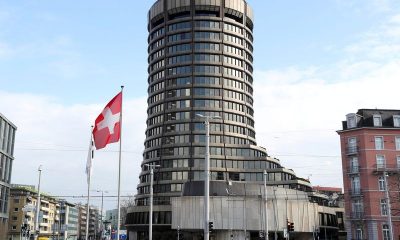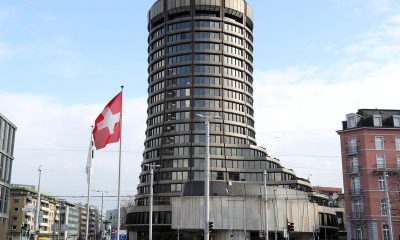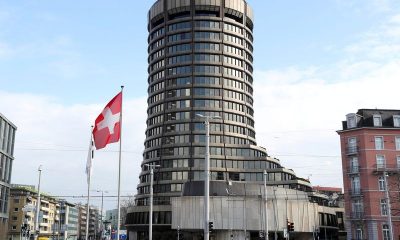Economy
Analysis-US bond investors eked out positive returns, see better second half year
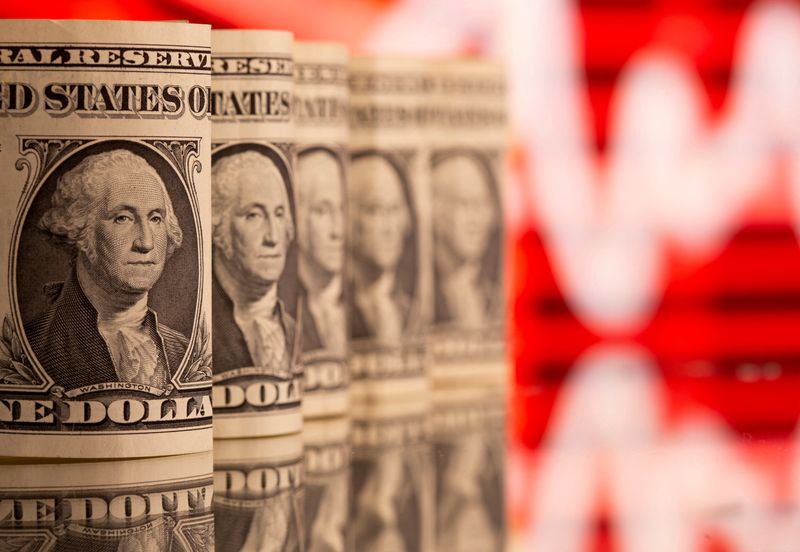
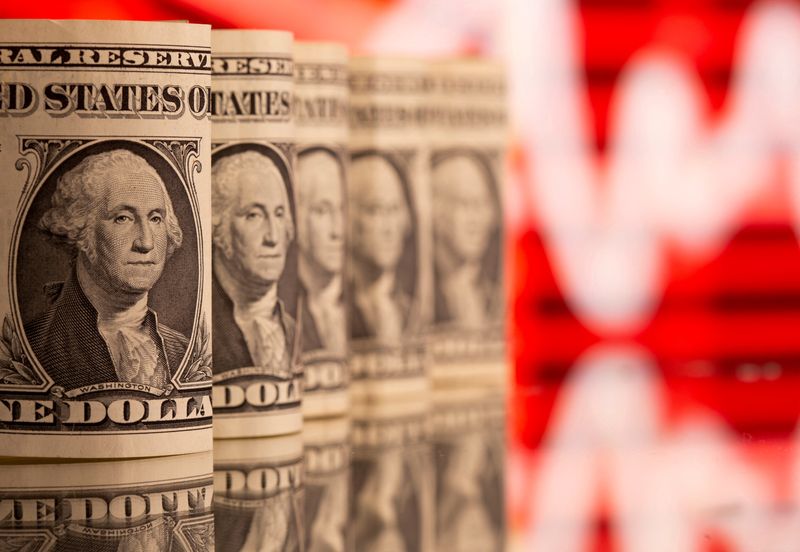
© Reuters. FILE PHOTO: U.S. One dollar banknotes are seen in front of displayed stock graph in this illustration taken, February 8, 2021. REUTERS/Dado Ruvic/Illustration/File Photo
By Davide Barbuscia
NEW YORK (Reuters) – U.S. government bond investors have racked up positive returns so far this year, with the higher income from bonds offering a buffer against market weakness if the Federal Reserve increases interest rates again.
It is a turnaround from the losses of 2022, which marked the end of a 40-year bull market in bonds, as the U.S. central bank rapidly hiked rates to curb the hottest inflation in more than four decades.
Rate hikes erode the value of existing bonds because new paper offers higher yields, but now, even if more hikes are coming, the bulk of monetary tightening is most likely over.
This leaves investors to focus on how to play a widely anticipated economic slowdown – generally a good scenario for bonds because when central banks ease rates to stimulate demand existing fixed-rate securities are worth more.
“The current level of yields on offer have not been seen since before the Global Financial Crisis,” said Arif Husain, chief investment officer and head of international fixed income at T. Rowe Price.
“As we see economic activity slow, high-quality duration has grown in appeal as investors see policymakers already having one eye on when to ease monetary conditions,” said Husain, referring to bonds’ sensitivity to interest rate changes.
Returns on U.S. bonds, including interest payments and price changes, totaled 2.4% so far this year, compared with negative 13% last year, according to the Morningstar US Core Bond TR USD index, which tracks fixed-rate, investment-grade U.S. dollar-denominated securities with maturities greater than one year.
The U.S. Treasury component of the US Broad Investment-Grade Bond Index has risen about 1.8% so far this year, after falling about 12.6% last year, the biggest annual decline since inception in 1980.
Some of the biggest bond funds have reflected this year’s improvement.
Year-to-date, the Vanguard Total Bond Market Index Fund, with nearly $300 billion in assets, posted a 2.56% return, Morningstar data as of June 20 showed. PIMCO’s flagship $122 billion bond fund, the Income Fund, posted a total return of 3.89%. BlackRock (NYSE:)’s iShares Core U.S. Aggregate Bond ETF, with nearly $92 billion in assets, posted a 2.58% return.
Rising rates tend to impact shorter-dated bonds more than longer ones. And higher borrowing costs increase the odds of a recession, when investors typically seek protection in longer-dated securities.
So far this year, Treasury yields – which move inversely to prices – have increased in the short part of the curve as the Fed raised rates another 75 basis points on top of 425 basis points last year. Two-year Treasury yields stood at 4.76% as of Tuesday, up from 4.4% at the beginning of the year.
However, longer-dated bond yields, which are driven by macroeconomic expectations more than short-term monetary policies, have either held steady or declined, as the market anticipated an economic slowdown. Benchmark 10-year Treasury yields, for instance, have declined to 3.77% from 3.8%.
“This means they have delivered positive returns from the interest they have earned over nearly half a year, and in the case where yields have declined, a small capital gain too,” said Husain.
The yield-to-maturity of government bonds, as measured by the ICE (NYSE:) BofA US Treasury Index, stood at 4.3% as of last week, up from 3.1% a year earlier.
If inflation remains stubbornly high, bond prices could still weaken, but given how much yields have already risen, the potential downside is marginal, some investors said.
At its last rate-setting meeting this month, the Fed anticipated two more hikes this year that would bring the fed funds rate to 5.6%.
“If we think of how much further they can tighten, that risk is now significantly lower than at the beginning of 2022,” said John Madziyire, senior portfolio manager and head of U.S. Treasuries and TIPS at Vanguard Fixed Income Group.
With the end of the hiking cycle in sight, and with high-quality bond yields at 4%-5%, investors can “get paid to wait,” said Emily Roland, co-chief investment strategist at John Hancock Investment Management.
“We still like bonds, even if we do see … potentially higher yields over the short term, because that income is now so compelling.”
Economy
Russian central bank says it needs months to make sure CPI falling before rate cuts -RBC


© Reuters. Russian Central Bank Governor Elvira Nabiullina attends a news conference in Moscow, Russia June 14, 2019. REUTERS/Shamil Zhumatov/File Photo
MOSCOW (Reuters) – Russia’s central bank will need two to three months to make sure that inflation is steadily declining before taking any decision on interest rate cuts, the bank’s governor Elvira Nabiullina told RBC media on Sunday.
The central bank raised its key interest rate by 100 basis points to 16% earlier in December, hiking for the fifth consecutive meeting in response to stubborn inflation, and suggested that its tightening cycle was nearly over.
Nabiullina said it was not yet clear when exactly the regulator would start cutting rates, however.
“We really need to make sure that inflation is steadily decreasing, that these are not one-off factors that can affect the rate of price growth in a particular month,” she said.
Nabiullina said the bank was taking into account a wide range of indicators but primarily those that “characterize the stability of inflation”.
“This will take two or three months or more – it depends on how much the wide range of indicators that characterize sustainable inflation declines,” she said.
The bank will next convene to set its benchmark rate on Feb. 16.
The governor also said the bank should have started monetary policy tightening earlier than in July, when it embarked on the rate-hiking cycle.
Economy
China identifies second set of projects in $140 billion spending plan


© Reuters. FILE PHOTO: Workers walk past an under-construction area with completed office towers in the background, in Shenzhen’s Qianhai new district, Guangdong province, China August 25, 2023. REUTERS/David Kirton/File Photo
SHANGHAI (Reuters) – China’s top planning body said on Saturday it had identified a second batch of public investment projects, including flood control and disaster relief programmes, under a bond issuance and investment plan announced in October to boost the economy.
With the latest tranche, China has now earmarked more than 800 billion yuan of its 1 trillion yuan ($140 billion) in additional government bond issuance in the fourth quarter, as it focuses on fiscal steps to shore up the flagging economy.
The National Development and Reform Commission (NDRC) said in a statement on Saturday it had identified 9,600 projects with planned investment of more than 560 billion yuan.
China’s economy, the world’s second largest, is struggling to regain its footing post-COVID-19 as policymakers grapple with tepid consumer demand, weak exports, falling foreign investment and a deepening real estate crisis.
The 1 trillion yuan in additional bond issuance will widen China’s 2023 budget deficit ratio to around 3.8 percent from 3 percent, the state-run Xinhua news agency has said.
“Construction of the projects will improve China’s flood control system, emergency response mechanism and disaster relief capabilities, and better protect people’s lives and property, so it is very significant,” the NDRC said.
The agency said it will coordinate with other government bodies to make sure that funds are allocated speedily for investment and that high standards of quality are maintained in project construction.
($1 = 7.1315 renminbi)
Economy
Russian central bank says it needs months to make sure CPI falling before rate cuts -RBC


© Reuters. Russian Central Bank Governor Elvira Nabiullina attends a news conference in Moscow, Russia June 14, 2019. REUTERS/Shamil Zhumatov/File Photo
MOSCOW (Reuters) – Russia’s central bank will need two to three months to make sure that inflation is steadily declining before taking any decision on interest rate cuts, the bank’s governor Elvira Nabiullina told RBC media on Sunday.
The central bank raised its key interest rate by 100 basis points to 16% earlier in December, hiking for the fifth consecutive meeting in response to stubborn inflation, and suggested that its tightening cycle was nearly over.
Nabiullina said it was not yet clear when exactly the regulator would start cutting rates, however.
“We really need to make sure that inflation is steadily decreasing, that these are not one-off factors that can affect the rate of price growth in a particular month,” she said.
Nabiullina said the bank was taking into account a wide range of indicators but primarily those that “characterize the stability of inflation”.
“This will take two or three months or more – it depends on how much the wide range of indicators that characterize sustainable inflation declines,” she said.
The bank will next convene to set its benchmark rate on Feb. 16.
The governor also said the bank should have started monetary policy tightening earlier than in July, when it embarked on the rate-hiking cycle.

 Forex3 years ago
Forex3 years agoForex Today: the dollar is gaining strength amid gloomy sentiment at the start of the Fed’s week

 Forex3 years ago
Forex3 years agoUnbiased review of Pocket Option broker

 Forex3 years ago
Forex3 years agoDollar to pound sterling exchange rate today: Pound plummeted to its lowest since 1985

 Forex3 years ago
Forex3 years agoHow is the Australian dollar doing today?

 Cryptocurrency3 years ago
Cryptocurrency3 years agoWhat happened in the crypto market – current events today

 World3 years ago
World3 years agoWhy are modern video games an art form?

 Commodities3 years ago
Commodities3 years agoCopper continues to fall in price on expectations of lower demand in China

 Economy3 years ago
Economy3 years agoCrude oil tankers double in price due to EU anti-Russian sanctions

